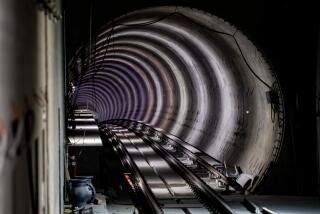Contractors claim Union Pacific is delaying bullet train project

The most ambitious rail project of California’s future is increasingly dependent on the cooperation of the very railroad that shaped the state’s past — and there are signs their relationship is growing strained.
Contractors building a 31-mile section of the high-speed rail project in the Central Valley have complained that the Union Pacific Railroad is causing delays and significant cost increases. The allegation could lead to a delay claim by the contractor against the state.
The friction involves Union Pacific’s “right of way,” the 100-foot-wide passage granted under President Abraham Lincoln, a former railroad attorney, in the 1860s as a way to develop the west.
It has remained core to the nation’s largest freight railroad: In a folksy television ad that has run periodically for half a century, employees sing, “We are the Union Pacific and we’ve got the right of way.”
It isn’t an idle boast that the company still values its property, as the California High Speed Rail Authority is learning while it tries to build alongside Union Pacific’s right of way in Fresno and Madera.
In a 2010 letter, Union Pacific warned the state that it would not tolerate any rail construction that impinged on its right of way or that limited its access to customers along its route. In 2015, the rail authority awarded a contract, now valued at $69 million, to cover Union Pacific’s costs.
The rail authority relies on Union Pacific’s cooperation not just for the Central Valley stretch. It also hopes to build about 30 miles of track on right of way owned by Union Pacific between Gilroy and San Jose. So far, Union Pacific has said simply that there is no agreement for that section.
The conflict surfaced in a June letter, which was obtained by The Times, from a team of contractors led by Sylmar-based construction giant Tutor Perini.
According to the letter sent to the rail authority, construction between Fresno and Madera is being delayed “solely due to the [Union Pacific Railroad’s] unreasonable rigid demands and unwillingness to cooperate.”
The letter lists more than 75 Tutor Perini design documents that Union Pacific refused to approve and returned with little explanation. The letter says the authority’s efforts to foster cooperation with the railroad “have not been fruitful.”
The letter cites 20 different areas where the railroad has interfered with the construction, including temporary tracks called shooflies, utility relocations and staging areas. Union Pacific, the letter claims, has refused to hold meetings to resolve issues. And it says the railroad has repeatedly violated a broad engineering and construction management agreement.
The rail authority’s failure to enforce the terms of that agreement “continues to severely impact the project cost and schedule,” the letter says.
The rail authority and Union Pacific say there is little discord.
Thomas Fellenz, chief counsel for the state rail authority, said he isn’t aware of “any specific tension that is occurring” with the freight railroad. Fellez said he met with Tutor representatives and can’t say yet whether Union Pacific is at fault for causing delays. So far, the rail authority hasn’t met with Union Pacific, he said.
Justin Jacobs, a Union Pacific spokesman, said in a statement that the two organizations “maintain open lines of communication.”
“Any proposed design or project details that do not meet the standards and requirements outlined in the original agreement may require re-submission,” he said. “Union Pacific and CHSRA will continue our good working relationship and proactive coordination on this project.”
Ron Tutor, chief executive of Tutor Perini, did not respond to a request for comment.
The Tutor Perini letter signals that the company may file another delay claim against the state. The team already received a $50 million settlement on a previous delay claim and last year a letter indicated it had another delay dispute worth more than $200 million. Fellenz said the only settlement has involved the $50 million deal.
Construction on the Madera to Fresno segment is years behind schedule, a result of the rail authority’s difficulties in acquiring land. The estimated cost of the segment was originally $1 billion, but it is now up to $1.5 billion — a 50% cost overrun, according to the rail authority’s July operations report. The entire project, which promises service between the Bay Area and Southern California in 2 hours and 40 minutes, is now 11 years behind its original schedule and its cost has grown from $33 billion to $77 billion.
In practice, Union Pacific exerts enormous legal and political power, said Jerome Schlichter, a St. Louis attorney who has litigated more than 100 cases against the company.
“They have a lot of lawyers,” he said. “They are a powerful force in the legislatures nationally and play very hard ball.”
Union Pacific will protect its right of way and has the power to significantly delay the project, said Stanford University history professor Richard White, noting that the railroad’s economic and political influence in the state stretches back 150 years.
Land grants allowed Union Pacific, along with the Southern Pacific line it would later acquire, to decide the locations of stations, which became the major cities of the Central Valley. Its vast land holdings later become the oil fields and almond orchards that drive the economy. Now, any mistake the state makes in managing bullet train project, White said, makes it vulnerable to the company.
“Union Pacific can’t stop the project, but it can delay it again and again,” White said.
Follow me on Twitter @rvartabedian
More to Read
Sign up for Essential California
The most important California stories and recommendations in your inbox every morning.
You may occasionally receive promotional content from the Los Angeles Times.











